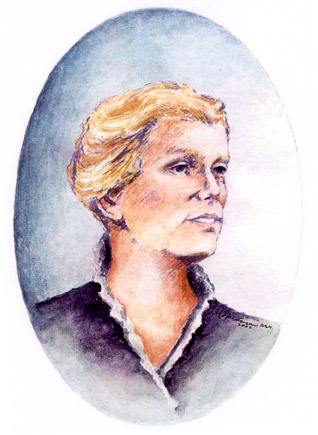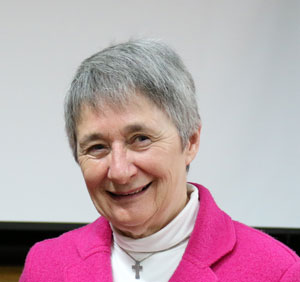September 24, 2018
Mercy Day
The ordinary is the bedrock of our daily lives. We associate the ordinary with the day to day, the usual, the normal, the commonplace. To quote Madeleine Delbrel (1938) who lived her life as a lay woman in the suburbs of Paris and who wrote eloquently and convincingly about the presence of God in the ordinary. 'This is where we find God, among the ordinary people we meet with on our streets, among ordinary men and women, who have ordinary lives, ordinary illnesses, ordinary bereavements, ordinary houses and who wear ordinary clothes'. (Nous autres gens des rues O.C. t.7, 23-24).

The ordinary is what provides a safe anchoring space which holds and steadies us especially at times of crisis in our lives or in the lives of those around us. On all levels of our being we can only sustain short periods of intensity and difference. Sooner or later we will get back to “the ordinary”. After the tension and stress of a funeral in a family, there is nothing more comforting than to sit quietly with loved ones and drink a cup of tea together.
For many people there is nothing more “ordinary” than eating a piece bread. So that there can be bread there is the need for light, heat, water and land. There is need for human intervention to prepare the ground and plant the seed. Then when the grain ripens it must be harvested, taken to the mill to be ground into flour. Then the flour is taken to the bakery (or the home) where it undergoes a process of preparation and cooking until finally the bread is ready to eat. How ordinary is this whole process? If we take the example a step further, there is nothing more ordinary than a white wafer of bread; there is nothing less ordinary then Eucharist.
Living the ‘ordinary’ is the foundation stone that enables us to appreciate and open up to the ‘extraordinary’.

Ordinary Time Good News
In the Liturgical Year, which gives a structure and rhythm to our deepening and developing relationship with God, the longest period of time is given over to Ordinary Time. The Church in her wisdom uses ordinary time over the three year period of the liturgical cycle to give us a chance to get to know Jesus intimately through a comprehensive reading of the three synoptic gospels, Matthew, Mark and Luke. Ordinary time then facilitates a quiet steady deepening of our relationship with Jesus through regular contact with him in the scriptures. This is what makes it possible for us to celebrate with joy the extraordinary moments of the liturgical year like the birth of Jesus as a human being at Christmas and his suffering, death and ultimate rising from the dead at Easter.
In the gospels themselves Jesus constantly uses ordinary images and examples to explain what he wants to say. He makes reference to sparrows and flowers, fig trees and vines, clouds and winds. He talks about searching for something lost and cleaning a house. He talks about sowing seed and caring for animals; he protects a child and he cooks breakfast. The gospels are so ordinary that a child can understand what is being taught and described. Yet, the gospels are so extraordinarily profound that not even the wisest in many lifetimes can plumb their depth.
Simplicity, Gospel ordinariness
Gospel ordinariness and simplicity are synonymous with fundamental realities like humility, poverty, meekness and gentleness; simplicity in the sense of unaffectedness, as the absence of complication, as frankness, straightforwardness and integrity. To the extent that simplicity is removed from the gospel context, to that extent it loses something of its freshness and ordinariness. Evangelical simplicity in a word is characterized by childlikeness, unpretentiousness, plainness and ordinariness (Simplicity and Ordinariness: Cistercian Studies Series no. 61, 14)
Ordinary people
People who live this gospel simplicity communicate tranquility, gentleness and strength in their ordinary day to day lives. Tranquility, gentleness and strength carry them through “the changes in the weather, the ups and downs of a journey, the inequalities of family and community life, emotional and professional disappointments, the sudden intervention of bad fortune or bad health, the rise and fall of our religious temperature”. (Evelyn Underhill, 1999, 73)
 Catherine McAuley was one such ‘simple’ person. She liked the ordinary, the unobtrusive and is quoted as saying; 'How silently the great God works. Darkness is spread over the earth and light comes at dawn, yet there is never a sound of curtains being drawn or shutters being closed'. This insight of Catherine is mirrored by Adrienne Von Speyr, in her book, The Handmaid of the Lord (1985, Ignatius Press, 43) where she notes that more excitement was generated around the conception of John the Baptist than about the conception of Jesus, emphasising that God‘s greatest miracles happen in silence and unobtrusiveness.
Catherine McAuley was one such ‘simple’ person. She liked the ordinary, the unobtrusive and is quoted as saying; 'How silently the great God works. Darkness is spread over the earth and light comes at dawn, yet there is never a sound of curtains being drawn or shutters being closed'. This insight of Catherine is mirrored by Adrienne Von Speyr, in her book, The Handmaid of the Lord (1985, Ignatius Press, 43) where she notes that more excitement was generated around the conception of John the Baptist than about the conception of Jesus, emphasising that God‘s greatest miracles happen in silence and unobtrusiveness.
It is through her letters that Catherine McAuley’s ordinariness and gospel simplicity are revealed clearly and unequivocally. In one letter (Jan 4, 1841, to Cecelia Marmion) Catherine, with great good humour recounts the simple fact that they had 'to keep hot turf under the butter in order to be able to cut it' because the weather was so cold in Birr in the winter of 1841. Her letters are full of anecdotes of ordinary everyday happenings; concern for somebody who is sick, rejoicing at someone’s success, sharing titbits of information and advice, commenting on someone’s behavior, delighting over a gift, and being devastated at the news of illness or a death. What makes her letters so attractive and readable is their unaffectedness and the warmth, friendliness, care for others and interest in the detail of the other person’s life that is evident in every line that she wrote. If, as J.H. Newman says, 'a person’s life lives in his/her letters', then Catherine’s letters portray a life of simplicity, warmth, humour, realism, love of people and an unswerving faith and trust in God.
It is through her very ordinariness that her strength of spirit and her holiness become visible. Her approach to living the corporal and spiritual works of mercy was simple and straightforward, as was her understanding of what it means to be merciful in the world in which one lives. She was aware that the poor need help today and not next week. 'I would rather be cold and hungry than the poor of Kingstown or elsewhere should be deprived of any consolation in our power to afford' (Letter to Mary Teresa White, November 1, 1838). If she saw someone in need, then she did what she could to help that person even if this meant inconvenience for herself as when she brought the homeless Mrs. Harper to live in Coolock and cared for her until her death.
 |
| Therese aged 15, a few days before she entered Carmel. Image: public domain |
Thérèse of Lisieux and Catherine McAuley are very alike in their ordinariness and simplicity. What C. de Meester says of Thérèse, can also be applied to Catherine; “by clinging to faithfulness in little things – the favoured ground of the poor, the simple, the realistic – she rescues holiness from the prejudice surrounding it” (‘Actualité de Thérèse de Lisieux’,Carmel, no. 16). Like Catherine McAuley before her, Thérèse knew 'that the mercy of God would accompany her forever'. The last line of the last letter Thérèse wrote was, “He is Love and Mercy … that is all!' Thérèse like Catherine realized that if we do not love mercy for its own sake we will never choose it. If we do not want mercy independently of the benefits we hope from it, we will never choose it. These two women, the one in the intensity of the interior life enclosed in a Carmelite convent and the other in the practical application of a similar insight walking the streets of the poor areas of a city, both women in very different circumstances arrive at the same understanding that Mercy lies at the heart of the Gospel and reveals the new face of God; both women were acutely aware that it was for Mercy that Jesus choose to die.
Mercy – a legacy of ordinariness
What is the legacy of Catherine McAuley’s ordinariness to those who share in the charism of mercy that is hers? Something of Catherine’s ordinariness has grown into the DNA of mercy women. Being ordinary and down to earth, the mercy woman is not squeamish about what life asks of her. Usually a mercy woman is someone who, in any day to day situation will “tuck up her sleeves” and do what has to be done. The charism of mercy calls her to care for the poor and needy and she does not recoil from "getting her hands dirty” by scrubbing, washing, cooking, doing the messages, cleaning a room, bathing a person. This has always been a hallmark of the woman of mercy and continues to be so today even as the expression of mercy takes other forms like caring for the poor earth, the homeless, the trafficked, the migrant, lobbying for justice and peace, being a voice for the voiceless.
One of the effects of being present to the day to day ordinary round of life for the mercy woman is that she grows into simplicity, serenity and strength. She recognizes that our small and changing lives are part of a greater mystery, they are part of the life that is related to God and known by God. Slowly by slowly, like Catherine, like Thérèse her trust in God deepens. She becomes strong in her conviction that she and all the other souls that she loves so much have their abiding place in eternity where the meaning of everything she does and bears is understood. She accepts that God is greater than her heart, than her work and she remains serene in this certainty, “as a weaned child in its mothers arms” (Ps.131).
Being ordinary is possibly one of the most secure places from which to open out to life and to persevere in doing so, as it implies accepting oneself as one really is before God neither more nor less. Being ordinary in this way means that the human tendency to compare self with others takes a back seat. Being ordinary in this way allows the soul to live serenely and with hope and so energy is focused on loving, returning love for the Love that is first offered to us. Being ordinary in this way helps us to find God present in the clink of the teacups, the everyday beauty of the daisy, the cheeky chirp of the robin, the laughter of a child, the mischievous wisecrack of the octogenarian.
May we never allow false expectations to divert our attention from the abundance of grace that is to hand in the ordinary? May we embrace and live to the full our ordinary everyday lives sure that there is no better way to love God and be the channels of his Mercy.
[complete article]
'Pour Out Compassion and Mercy' composed by Briege O'Hare OSC, sung by Maree Cox rsm (The Congregation).*Purchase on iTunes
'Let Nothing Disturb You' composed by Briege O'Hare OSC, sung by Maree Cox rsm (The Congregation). Purchase on iTunes
Bro, B., O.P. (1974) The Little Way: The Spirituality of Therese of Lisieux , London, DLT.
Merton, T. OCSO., (1980), Thomas Merton on Saint Bernard: Part II; St Bernard on Interior Simplicity, Michigan, Cistercian Publications, 111-157.
Sommerfeldt, J.R., (1980), ed., Simplicity and Ordinariness; studies in medieval Cistercian history, Michigan, Cistercian Publications.
Sullivan, M.C., (2004) ed., The Correspondence of Catherine McAuley 1818 – 1841, Dublin, Four Courts Press.
Sullivan, M.C., (2012), The Path of Mercy: The Life of Catherine McAuley, Dublin, Four Courts Press.
Underhill, E., (1999), The Spiritual Life: Great Spiritual Truths for Everyday Life, Oxford, One World.
Messages to: Brenda Dolphin rsm
 Brenda Dolphin rsm lives in Rome and since September 2006 has served as the Postulator for the Cause for the Canonisation of Catherine McAuley.
Brenda Dolphin rsm lives in Rome and since September 2006 has served as the Postulator for the Cause for the Canonisation of Catherine McAuley.
Sr Brenda is a faculty member in the Institute of Psychology at the Pontifical Gregorian University and was previously on the Congregational Leadership Team for the Congregation of the Sisters of Mercy (Ireland).